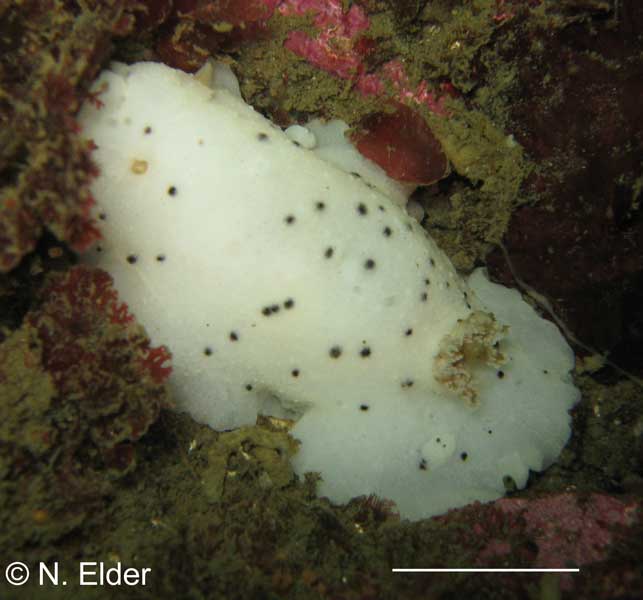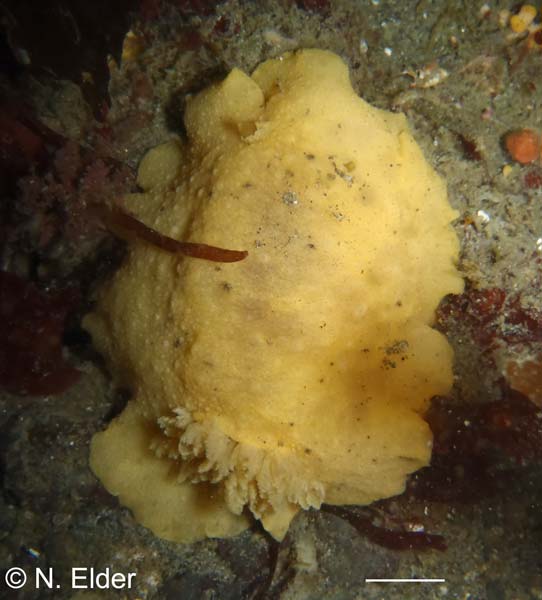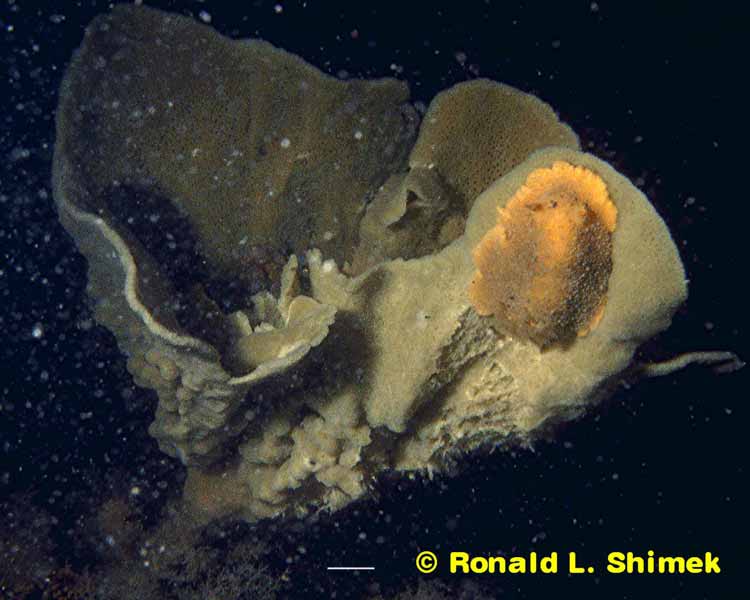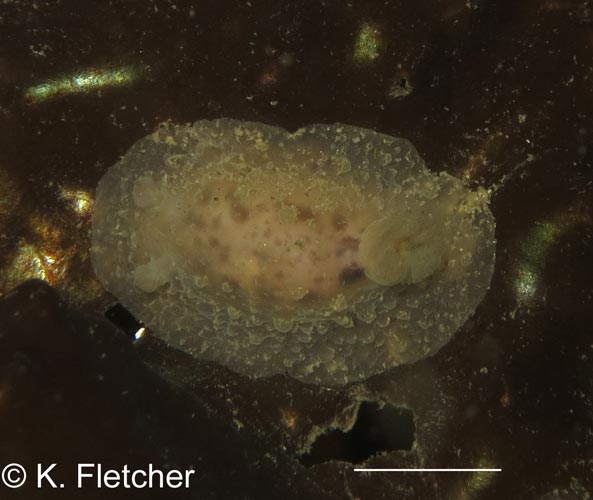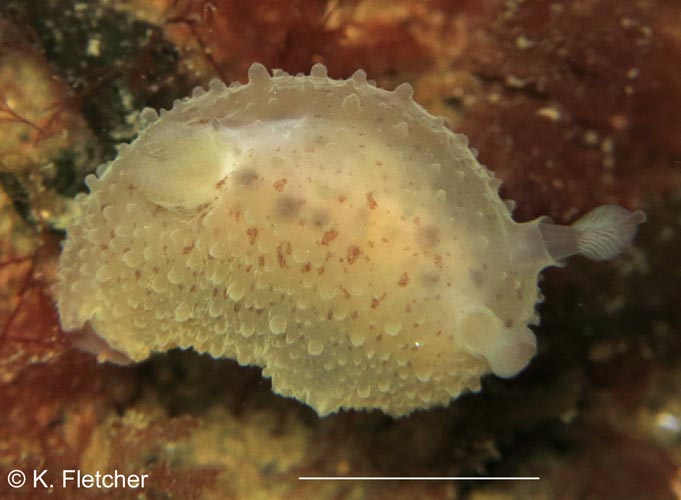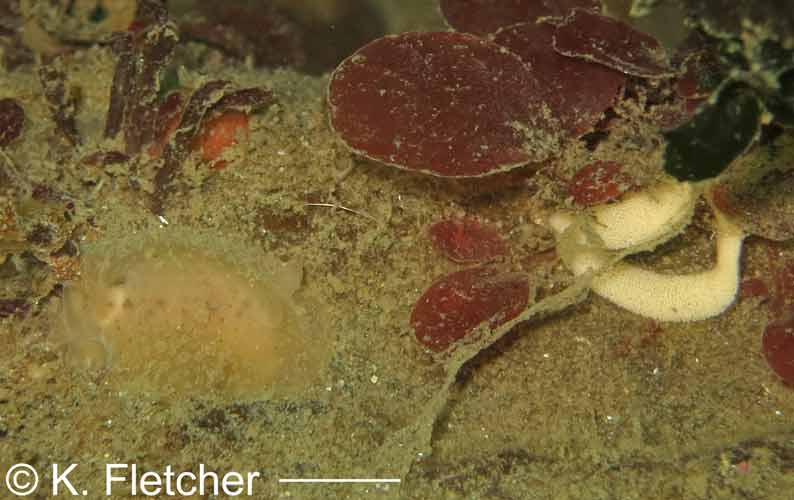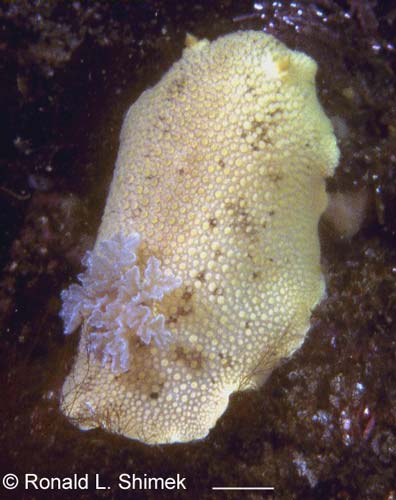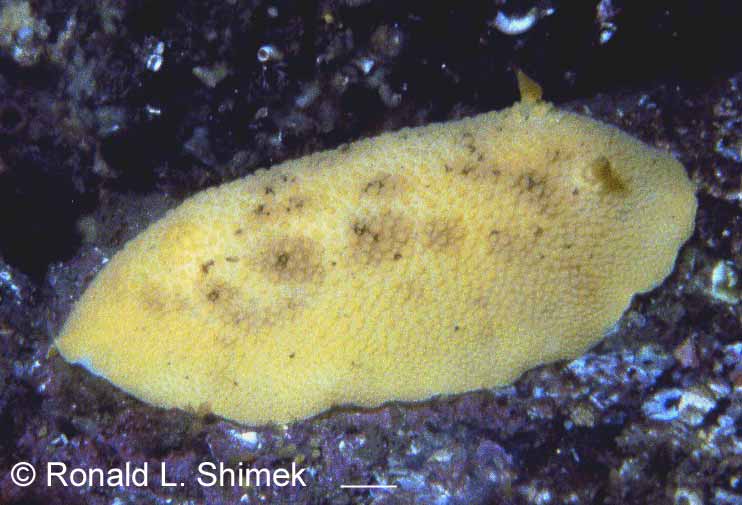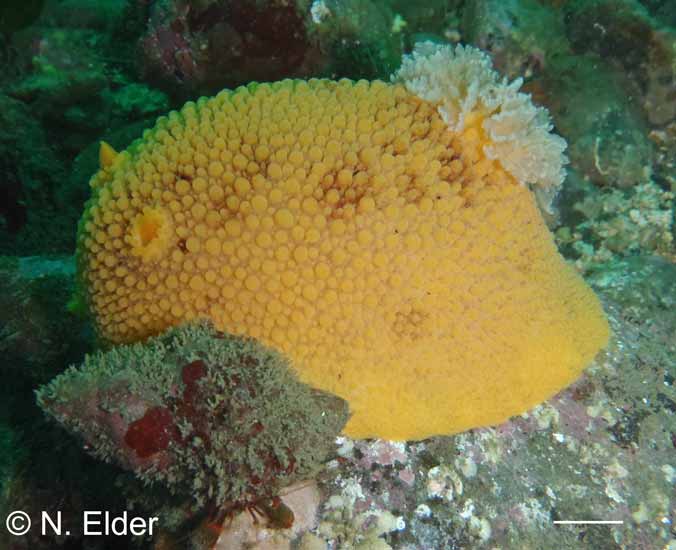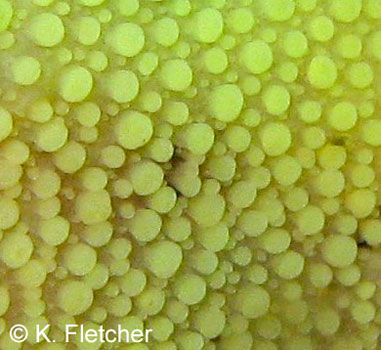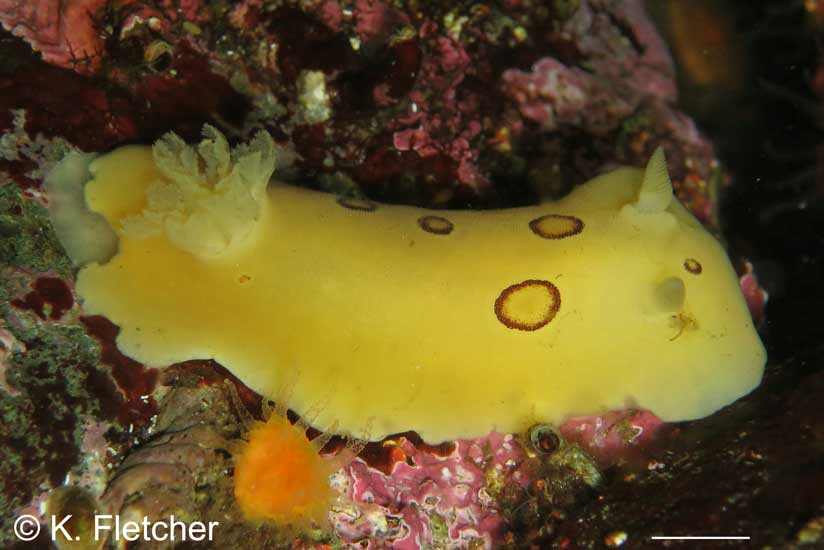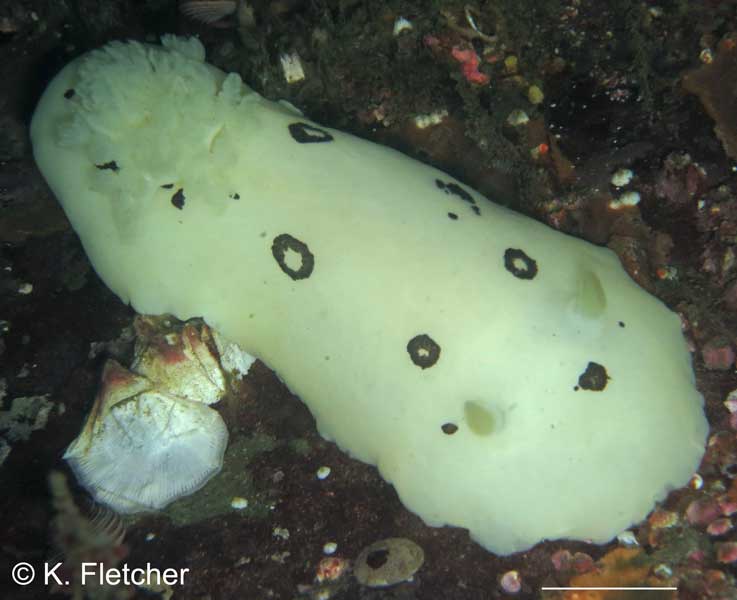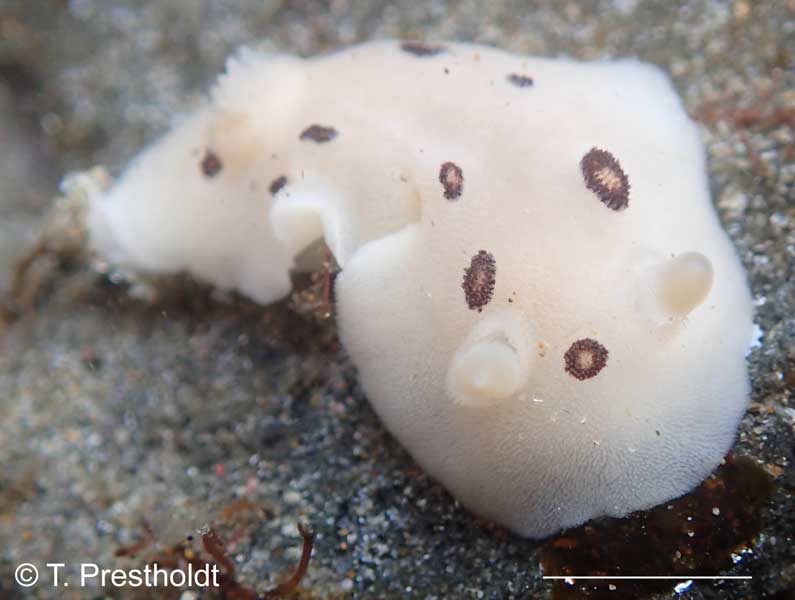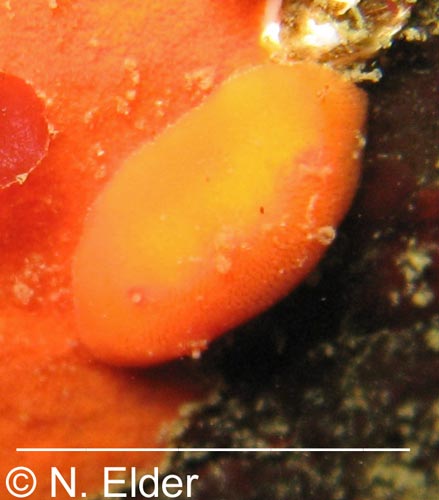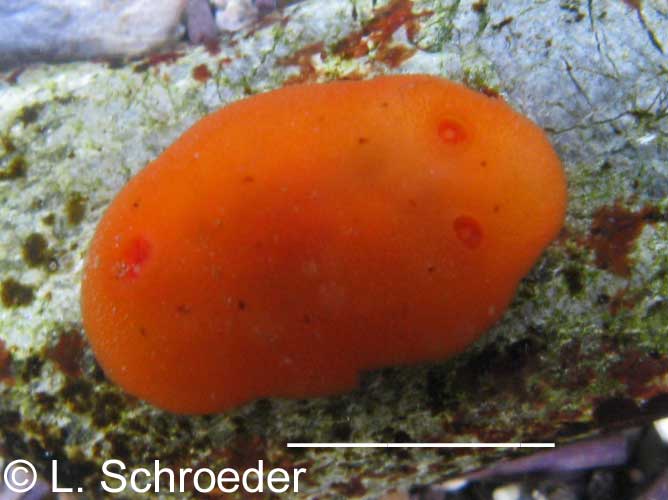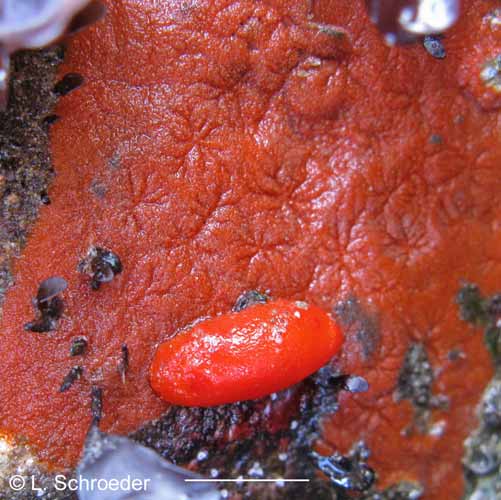Nudibranchs and other Sea Slugs
Order Pleurobranchida &
Order Nudibranchia - Suborder Doridina
Order Pleurobranchida
Click on photo to enlarge. Scale line in photo equals 1cm unless otherwise specified.
* Species which are the most commonly encountered nudibranchs on the beach.
Corambidae
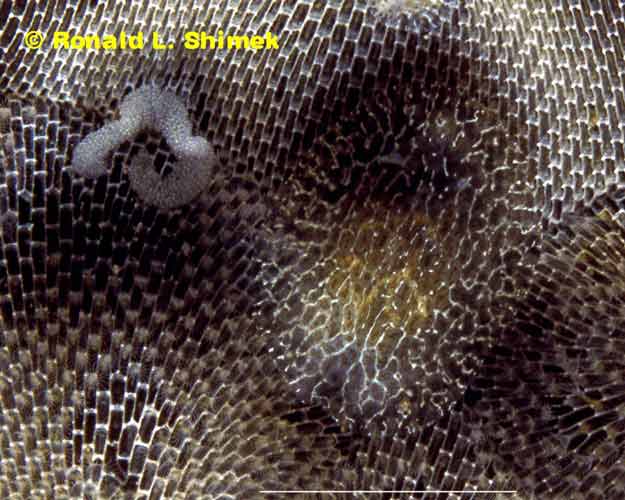 Turn Island, WA, subtidal, with eggsCorambe steinbergae (Lance, 1962)Cryptic Nudibranch or Steinberg's Corambeintertidal to subtidal size to 17mmnorthern Mexico to central AlaskaThis species so resembles the bryozoan on which it
Turn Island, WA, subtidal, with eggsCorambe steinbergae (Lance, 1962)Cryptic Nudibranch or Steinberg's Corambeintertidal to subtidal size to 17mmnorthern Mexico to central AlaskaThis species so resembles the bryozoan on which it
lives that it is very difficult to spot.
(previous name - Doridella steinbergi)
Order Nudibranchia - Suborder Doridina
Those
in the order Nudibranchia are the true nudibranchs. The adult forms
have a complete
absence of a shell and have externally exposed respiratory
organs.
Ancula gibbosa (Risso, 1818)
Humped Ancula
subtidal to at least 27m size to 33mm
southern California to Alaska; north Atlantic; Meditteranean to northern Europe
This
species may be plain in coloration, with white spots or with three
orange stripes plus orange tips on the appendages.
(previous name - Ancula pacifica)
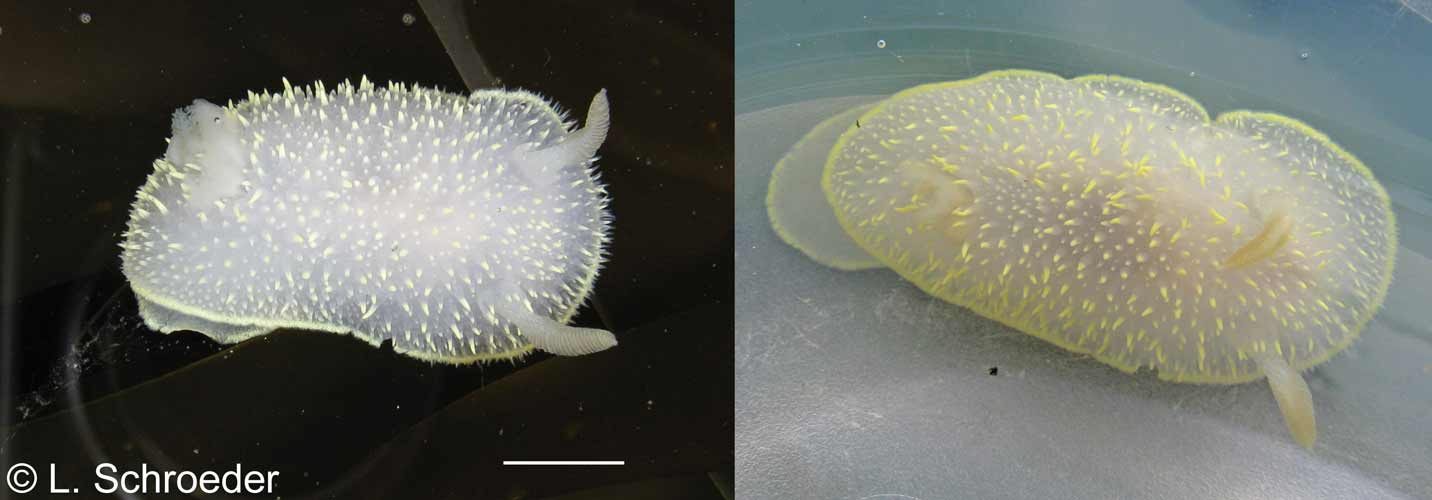 Gabriola Island, BC, intertidal (same specimen in wild and in container)Acanthodoris hudsoni MacFarland, 1905
Gabriola Island, BC, intertidal (same specimen in wild and in container)Acanthodoris hudsoni MacFarland, 1905
Hudson's Horned Dorid
intertidal to 25m southern California to southern Alaska size to 40mm
This
is infrequently found intertidally. It is white with yellow
tipped papillae, rhinophores and papillae. The edge of the body
is also yellow. Looks very similar to Cadlina luteomarginata, but this species has tall, conical papillae and the Cadlina has short, stubby tubercles.
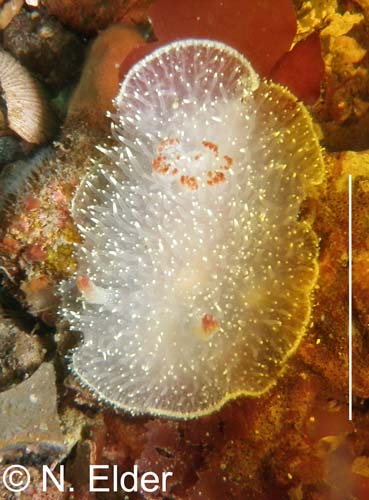
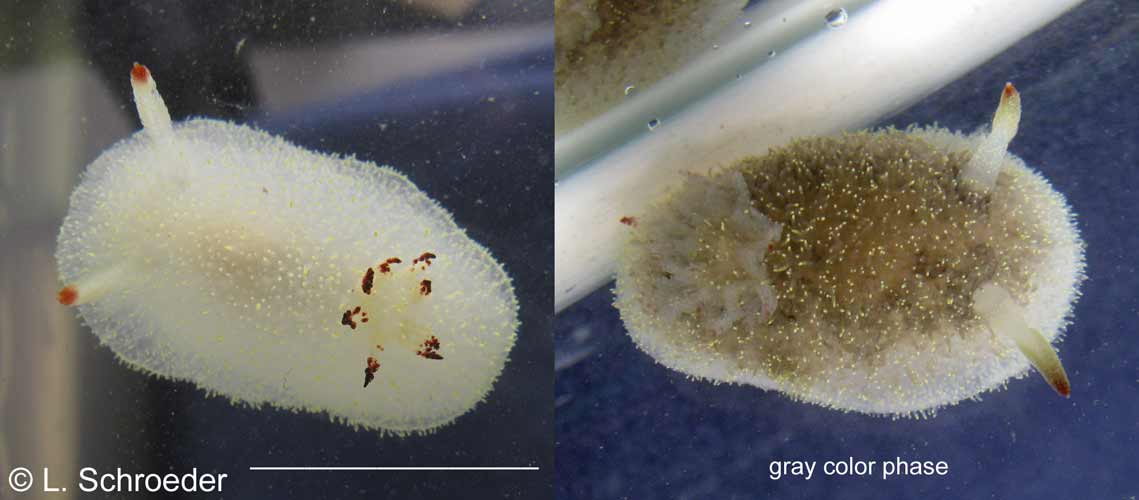
Low Point, WA, subtidal
Anacortes, WA, photographed in an aquarium
Acanthodoris nanaimoensis O'Donoghue, 1921Nanaimo Horned Doridintertidal to 25m southern California to central Alaska size to 40mm
It
is occasionally found intertidally in the Pacific Northwest. The
maroon tipped rhinophores and branchial plume are distinctive,
although the amount of maroon can vary. This species has a gray
color phase.
 Waldron Island, WA, subtidal
Waldron Island, WA, subtidal
Ceratodoris vancouverensis
(O'Donoghue, 1921)Vancouver Okeniasubtidal to 25m size to 18mmnorthern WA to northern BCThis species is speckled white with a broad body.
(synonym - Okenia vancouverensis)

 Whiskey Creek, OR, intertidalCeratodoris rosacea (MacFarland, 1905)Hopkin's Roseintertidal to 6m size to 20mm northern Mexico to southern Oregon
Whiskey Creek, OR, intertidalCeratodoris rosacea (MacFarland, 1905)Hopkin's Roseintertidal to 6m size to 20mm northern Mexico to southern Oregon
This species is only found in Oregon during extremely warm summers. It is very distinctive with long rose pink papillae.
(synonyms - Okenia rosacea, Hopkinsia rosacea)
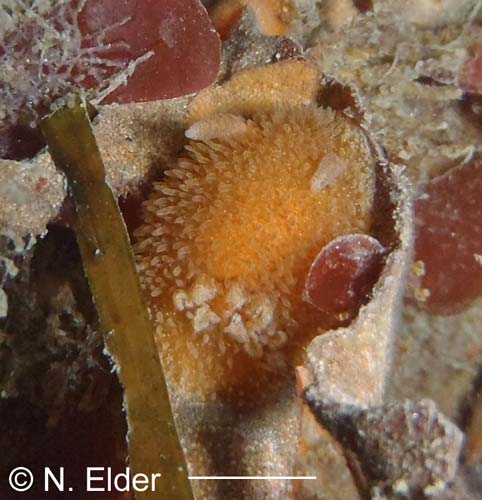
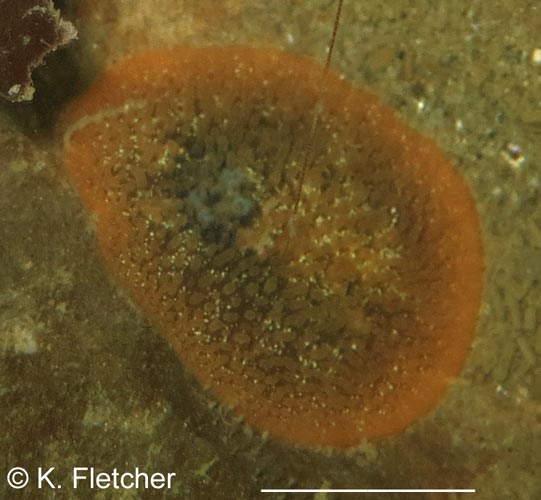
Freshwater Bay, WA, subtidal Rich Passage, WA, subtidal
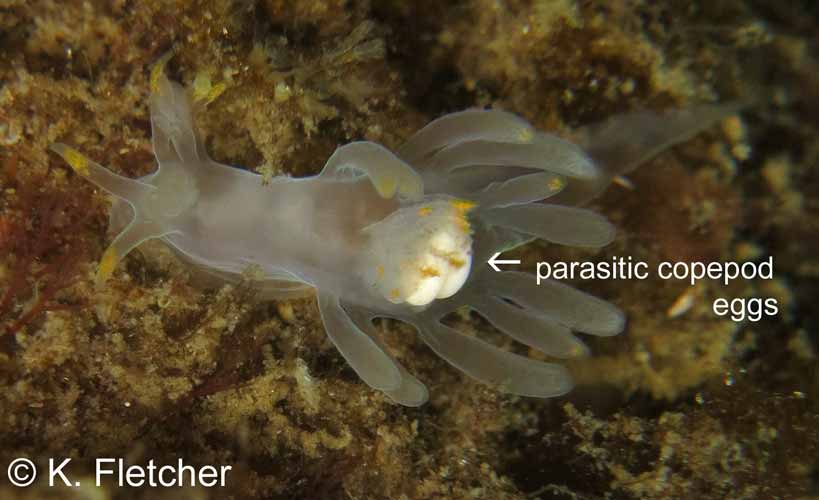 Rich Passage, WA, subtidal
Rich Passage, WA, subtidal
Discodorididae
Oak Bay, WA, intertidal
Green Point, WA, subtidal
Port Angeles, WA, subtidal Diaulula odonoghuei Steinberg, 1963
Spotted Leopard Dorid *
intertidal to 35m? northern California to Alaska; Sea of Japan size to 12.5cm
This
species can be found intertidally at very low tides or subtidally if in
protected bays. Search under rocks in tidepools. The color can be variable shades of brown
or white with few or many solid spots which extend onto the mantle
margin. This species was recently reinstated and is now separated
from Diaulula sandiegensis.
Oak Bay, WA, intertidal
Petersburg, AK, intertidal
Bainbridge Island, WA, subtidal
Acanthodoris lutea MacFarland, 1925
Yellow Horned Dorid
subtidal size to 30mm
northern Mexico to southern BC
This
species is typically a bright orange with yellow specks. If
brought to the surface, it exhibits the strong odor of sandalwood.
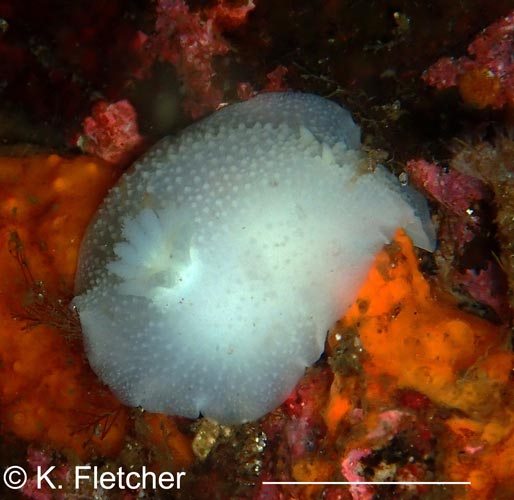 Redonda Is., BC, subtidal
Redonda Is., BC, subtidal
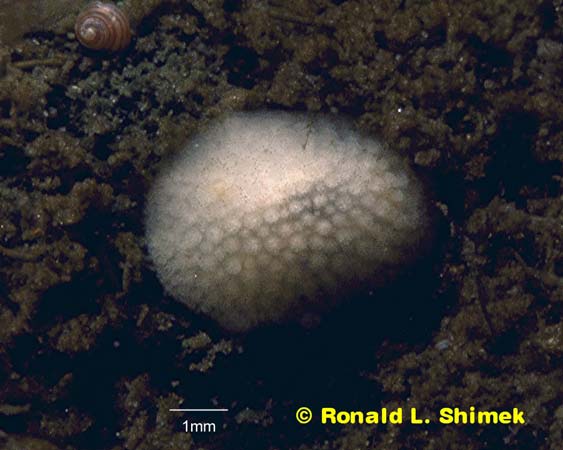
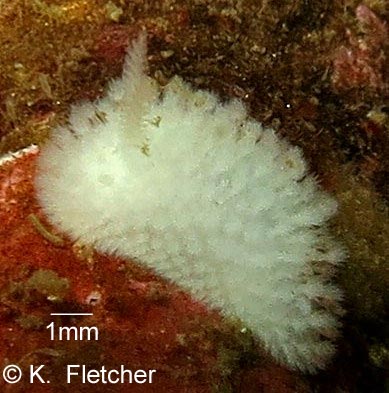
Barkley Sound, BC, subtidal Blake Island, WA, subtidal
Onchidoris evincta (Millen, 2006)
low intertidal to 15m size to 16mm
central Oregon to southern Alaska
This
is rarely found intertidally. The species is white. It has
a crown of spicules at the tip of each tubercle which give it a fuzzy
appearance from a distance.
(previous name - Adalaria evincta)
Calycidorididae
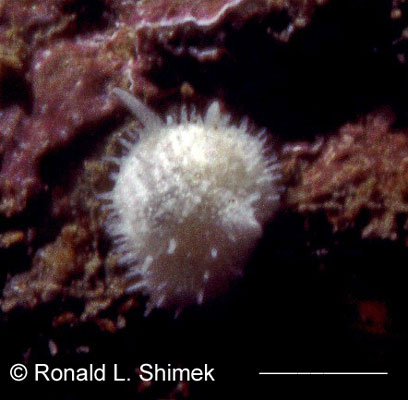
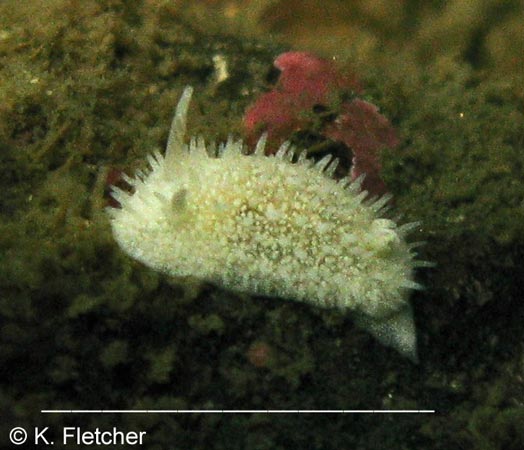 San Juan Islands, WA, subtidal
San Juan Islands, WA, subtidal
Diaphorodoris lirulatocauda Millen, 1985Porcupine Dorid or Ridge-tailed Doridintertidal to subtidal size to 12mmnorthern Mexico to southern AlaskaThis
species is infrequently found intertidally. It has very long
rhinophores and papillae, and a long ridged tail. The body
exhibits opaque white specks.
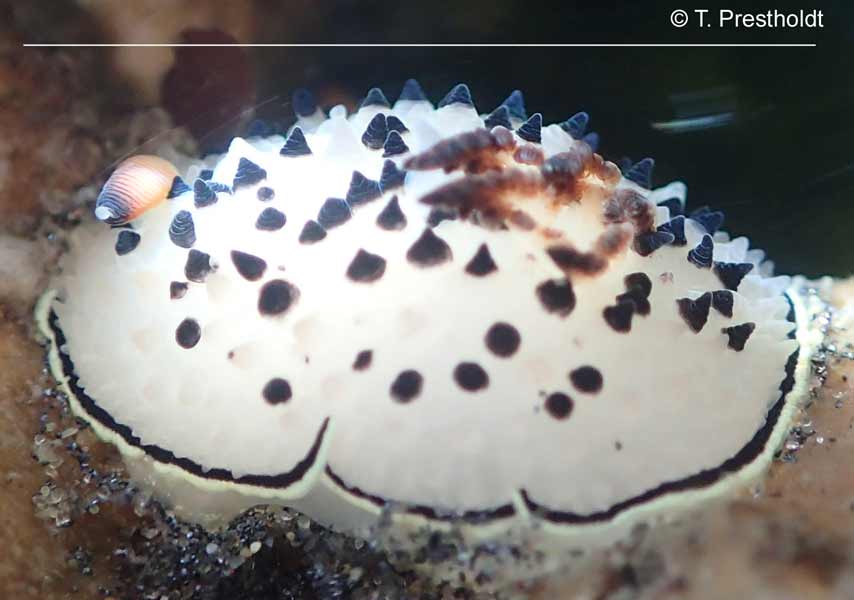
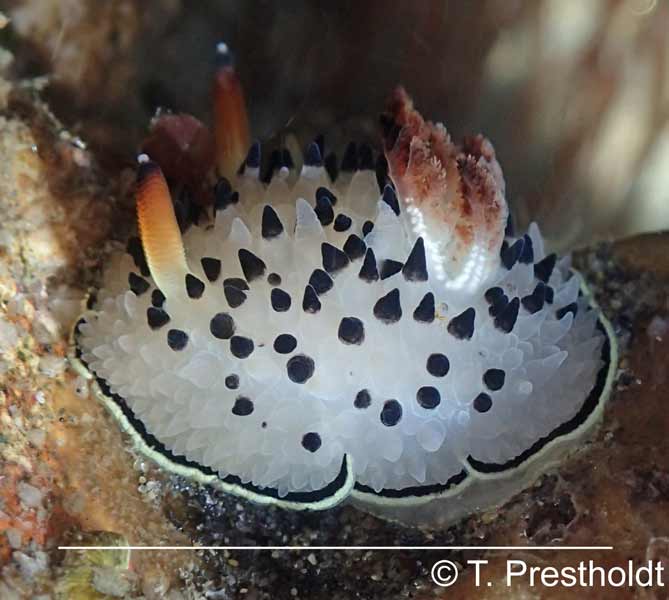 Netarts Bay, OR, intertidalAcanthodoris rhodoceras Cockerell & Eliot, 1905
Netarts Bay, OR, intertidalAcanthodoris rhodoceras Cockerell & Eliot, 1905
Black-Tipped Spiny Dorid
low intertidal to 18m northern Mexico to Netarts, Oregon size to 28mm
This
species is rarely seen in its northern range, generally during
very warm summer years. It is distinctly marked with black-tipped
papillae and a black and yellow line around the base of the body.
The rhinophores are tipped in reddish-brown to black.
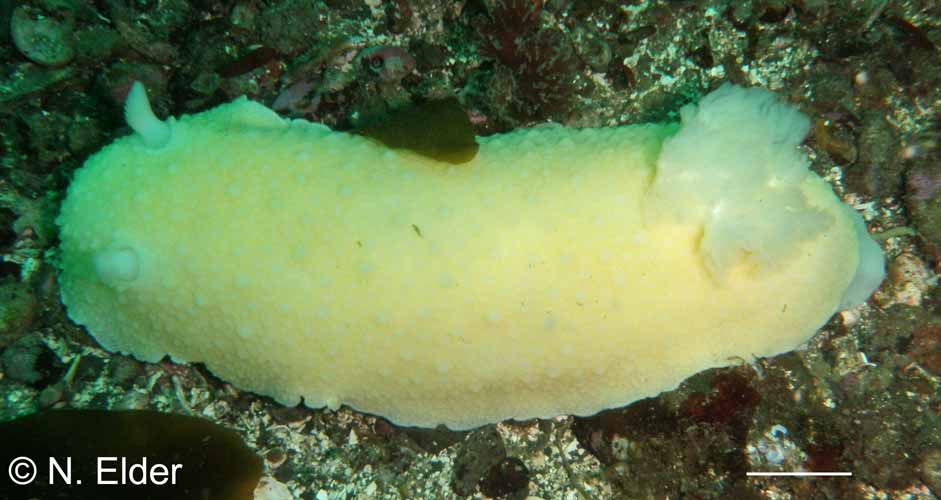
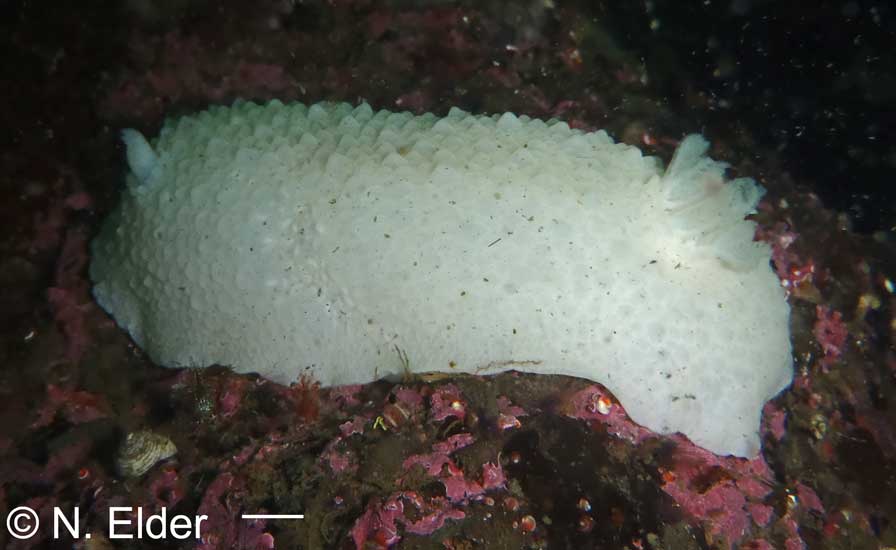
Low
Point, WA, subtidal
Port Angeles, WA, subtidal
Doris odhneri (MacFarland, 1966)Odhner's Doridintertidal to 50m southern California to northern Alaska size to 20cmIt is rare to find this species intertidally in the northwest. It is a very large species and may be white to creamy yellow. It has no dark markings.(previous name - Archidoris odhneri)
Dorididae
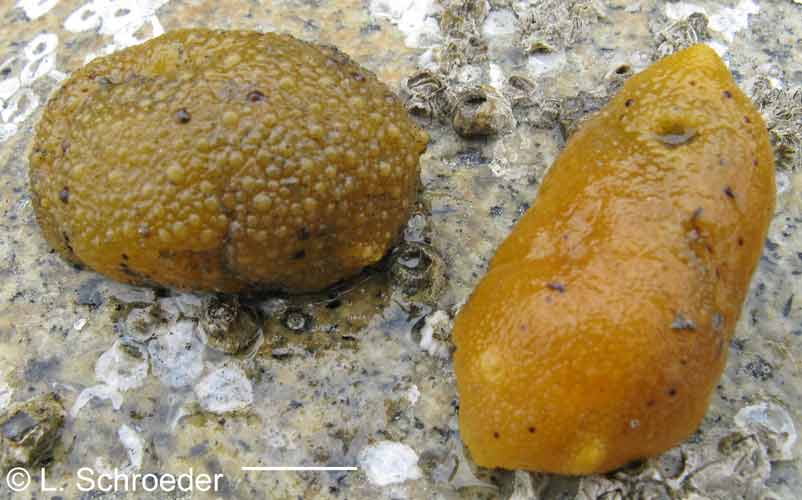
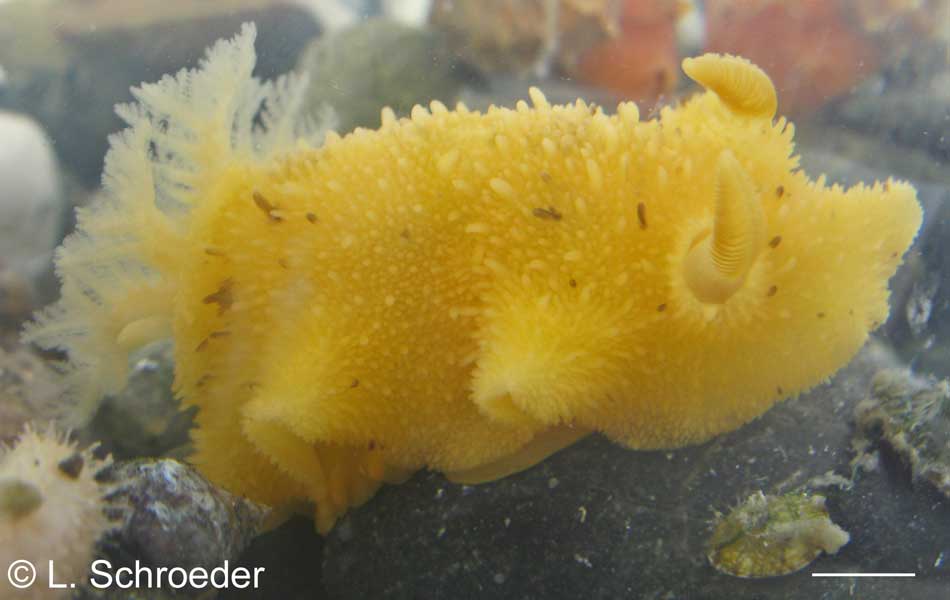
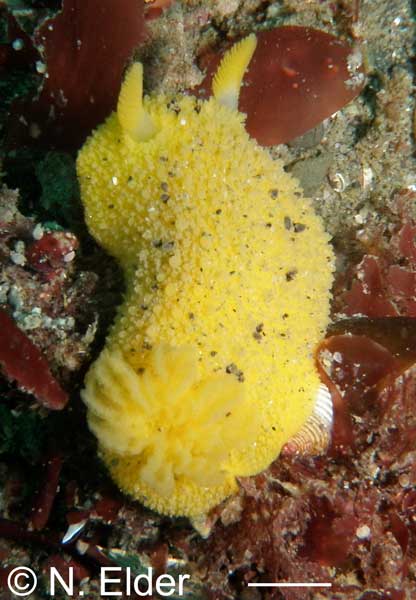
Whiskey Creek Beach, WA, intertidal
Bremerton, WA, intertidal
Green Point, WA, subtidal
Doris montereyensis (Cooper, 1862)Monterey Sea Lemon *intertidal
to 256m southern California to
southern Alaska size to 15cmThis very common species is the yellow one most frequently found intertidally. It can reach 15cm but it
is usually the smaller specimens found near shore. The color is
usually yellow but can also be white or brownish. A varying number of black spots usually cover some of the irregularly sized tubercles. The spots are only on the tubercle. The gill is yellow.
(previous name - Archidoris montereyensis)

 Rich Passage, WA, subtidal
Rich Passage, WA, subtidal
Atalodoris jannae (Millen, 1987)subtidal central California to central Alaska size to 15mm
This
species is creamy white to pale yellow in the north and lemon yellow to
orange in the south. The tubercles are rounded. It has a
distinctive white gland on its rear.(synonyms - Knoutsodonta jannae, Adalaria jannae)
Aldisa tara Millen, 1985
King's Aldisa
subtidal, 4-24m south BC size to 27mm
This
species is translucent white with dull white speckles. The
tubercles have spicules which can contract and change the appearance
from tuberculate to smooth.
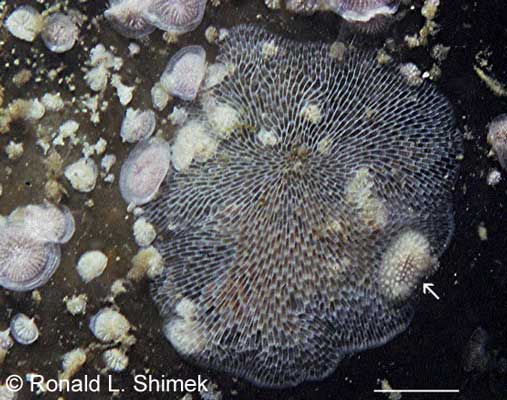
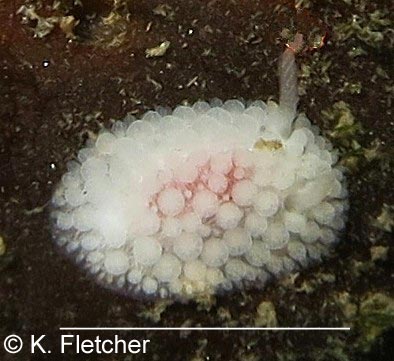
Barkley Sound, BC, subtidal
Rich Passage, WA, subtidal
Onchidoris muricata (Müller, 1776)Fuzzy Onchidorisintertidal to 18m size to 18mmsouthern California to northern Alaska; circumboreal - France to Russia and Greenland to ConnecticutThis is occasionally found intertidally. It feeds on encrusting bryozoans and has numerous club-shaped tubercles.(previous name - Doris muricata)
Aegiridae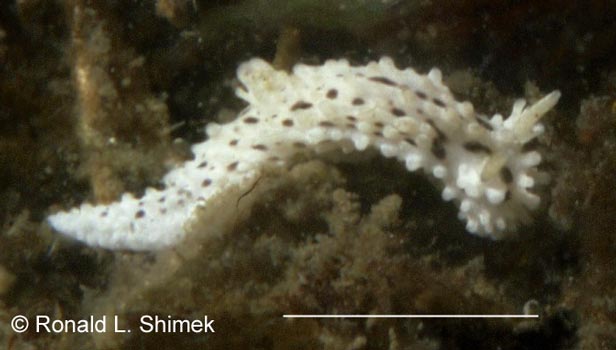 Barkley Sound, BC, subtidal
Barkley Sound, BC, subtidal
Aegires albopunctatus MacFarland, 1905White-spotted Doridsubtidal to 30m size to 23mmnorthern Mexico to southernmost AlaskaThis species feeds on calcareous sponges. Dark spots decorate its white body.
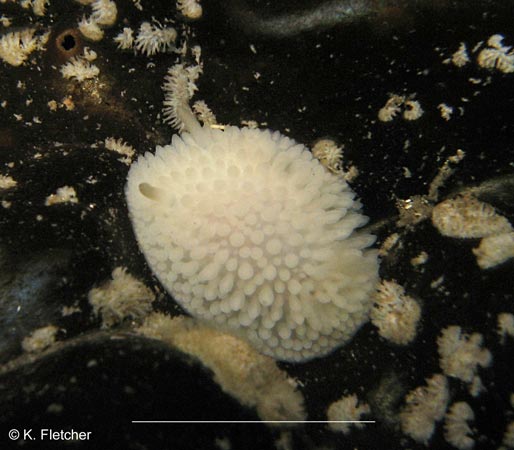 Galiano Island, BC, subtidalAdalaria proxima (Alder & Hancock, 1954)Tuberculate Doridshallow subtidal size to 20mm
Galiano Island, BC, subtidalAdalaria proxima (Alder & Hancock, 1954)Tuberculate Doridshallow subtidal size to 20mm
southern BC to northern Alaska; circumboreal; Sea of Japan,Greenland to New England, Britain to Norway
This species is white with long tubercles which have a star-like pattern of spicules at their base. The tubercles are more pointy than round.
(previous names - Onchidoris proxima, Doris proxima)
Turn Island, WA, subtidal
Green Point, WA,
subtidal Anacortes, WA, intertidal
Limacia cockerelli (MacFarland, 1905)Cockerell's Doridintertidal to 35m northern Mexico to southern Alaska size to 26mmThis species is sometimes seen intertidally. The bulbous red-orange tips on the papillae are distinctive.
(previous name - Laila cockerelli)
Polyceridae
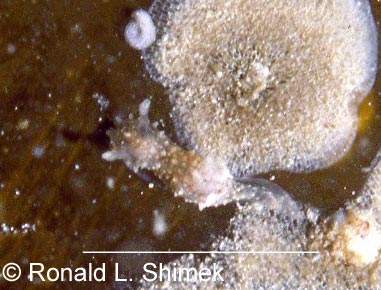
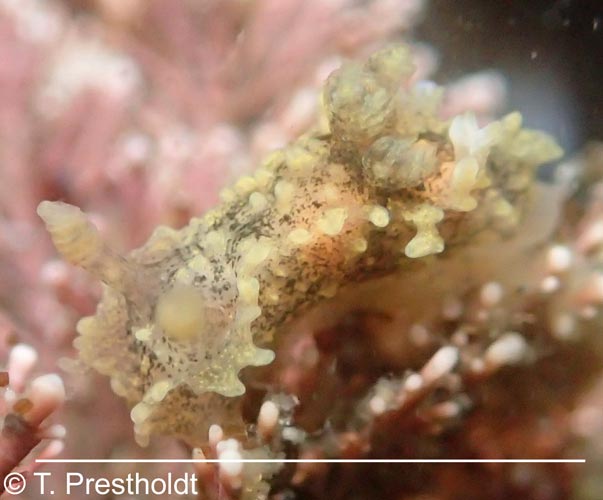
Camano Island, WA, subtidal
Seal Rock, Oregon,
intertidal
Palio dubia (M. Sars, 1829)Dubious Dorid
intertidal to subtidal size to 12mm
central Mexico to southern Alaska; Japan
This is infrequently found intertidally. It feeds on bryozoans coating the understory kelps and eelgrass.
(previous name - Polycera dubia)
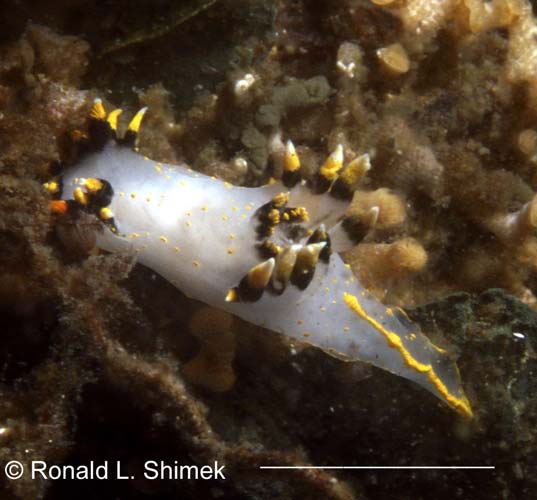
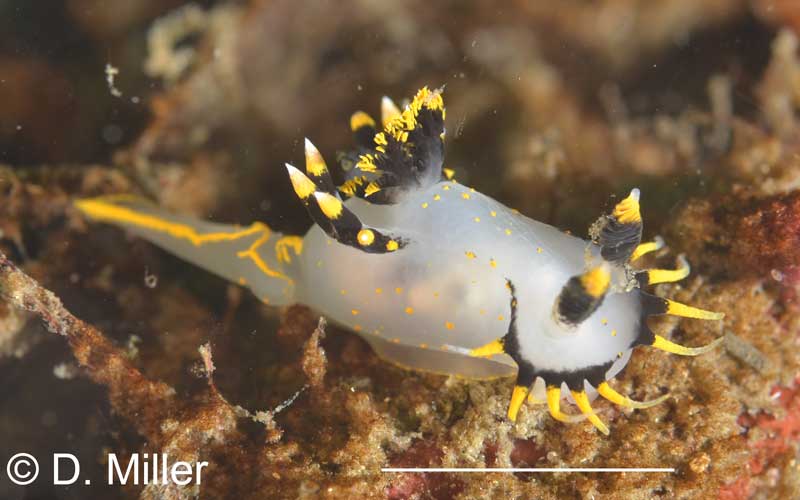 both photos Barkley Sound, BC, subtidal
both photos Barkley Sound, BC, subtidal
Polycera tricolor Robillard, 1971Three-colored Doridsubtidal to 60m size to 30mmnorthern Mexico to southermost AlaskaThis distinctive looking species lives only along exposed coastlineand not in protected waters such as the Salish Sea.
Barkley Sound, BC, subtidal Neah Bay, WA, subtidal
Aldisa cooperi Robilliard & Baba, 1972Cooper's Aldisaintertidal to 23m size to 25mmnorthern California to southern Alaska; JapanThis is infrequently found intertidally. It may be lemon yellow to bright orange and has a row of black spots down the middle of
the back.
(previous name - Aldisa sanguinea cooperi)
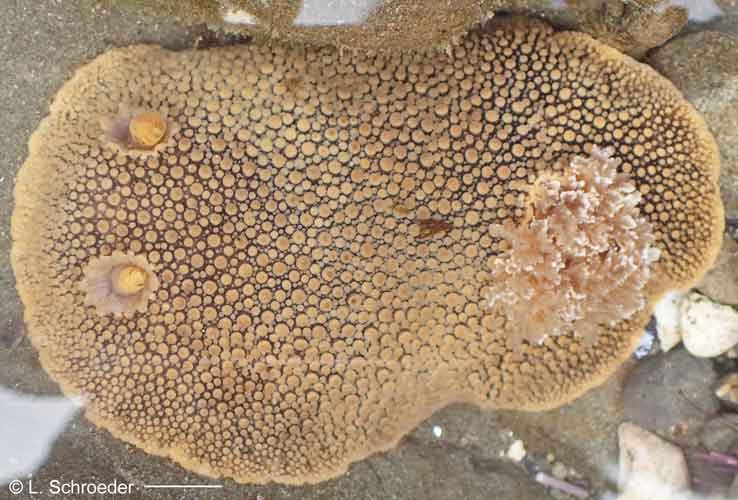 Cape Arago, OR, intertidal
Cape Arago, OR, intertidalPeltodoris nobilis (MacFarland, 1905)
Noble Sea Lemon
intertidal to 228m northern Mexico to central Alaska size to 25cm
This
is usually only found intertidally on the outer coast. While it can attain a great
size, it averages just 52mm. It may be yellow to orange and may have darker color patches.
The color from the patches does not extend up the tubercles as they do on M. lentiginosa or D. montereyensis. The tubercles on this species are also larger than on M. lentiginosa,
a very similar looking species. The gill is white. Left photo
shows a specimen where the dark patch covered the entire dorsal
surface. Not to be confused with Doris nobilis Odhner, 1907, an Atlantic species.
(previous name - Montereina nobilis, Anisodoris nobilis)
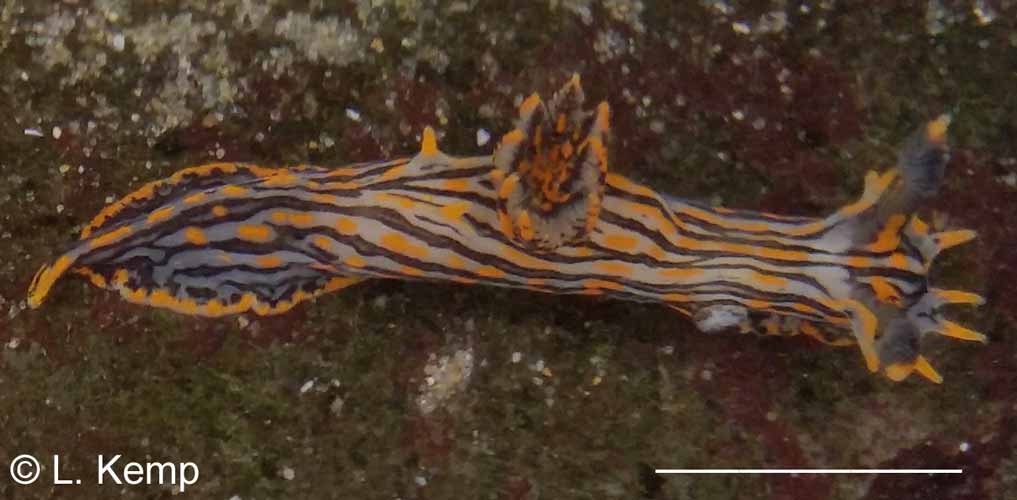 Neptune State Park, OR, intertidalPolycera atra MacFarland, 1905Black Dorid or Sorcerer's Nudibranchintertidal to 50m size to 22mm, can be up to 50mm
Neptune State Park, OR, intertidalPolycera atra MacFarland, 1905Black Dorid or Sorcerer's Nudibranchintertidal to 50m size to 22mm, can be up to 50mm
northern Mexico to central Washington
This
species is usually only seen in its northern range during very warm
summer years. It can be somewhat variable in color but is noted
for the longitudinal black stripes along it's body and orange-yellow
spots.
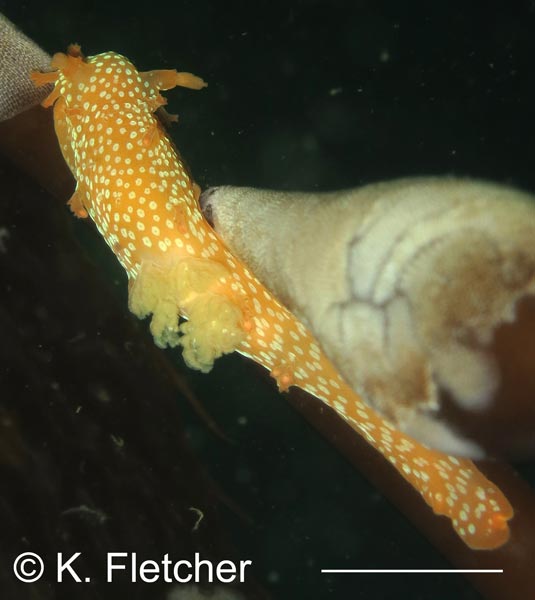
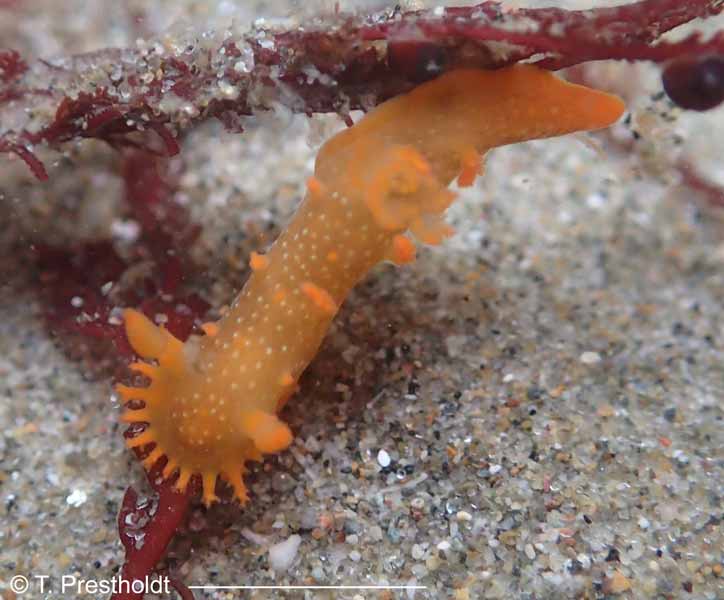
Neah Bay, WA, subtidal
Seal Rock, OR, tide pool
Triopha maculata MacFarland, 1905Spotted Doridintertidal to at least 33m size usually 20-50mm, but up to 180mmnorthern Mexico to Port Hardy, BCThis
species is rarely seen in WA and BC. It seems to arrive only
during extremely warm summers. It's color is variable and may be
yellow, orange, red or brown. The body is covered with spots of
white to pale blue. The frontal veil has many branched processes.(synonym - Triopha grandis)


Hornby Island,
BC, subtidal close-up of tubercles
Peltodoris lentiginosa (Millen, 1982)
Freckled Dorid
intertidal to 33m southern Oregon to central Alaska size to 18cm
This species is rare to find intertidally. It is white to pale yellow with darker patches scattered randomly over its back. The tubercles are small and the color from the dark patches extends up the tubercles.
(previous names - Anisodoris lentiginosa, Diaulula lentiginosa)
Triopha catalinae (Cooper, 1863)
Catalina Clown Dorid *
intertidal to 80m + northern Mexico to southeast Alaska size to 15cm
This
species is more commonly found on the outer coast and western half of
the Strait of Juan de Fuca. It is less common in the Salish Sea
The body may be translucent to opaque white. The
rhinophores may be orange to reddish orange. The tubercles on the
back of the body are knobby but not branched. This is an
important difference between this species and T. modesta.
(synonym - Triopha carpenteri)
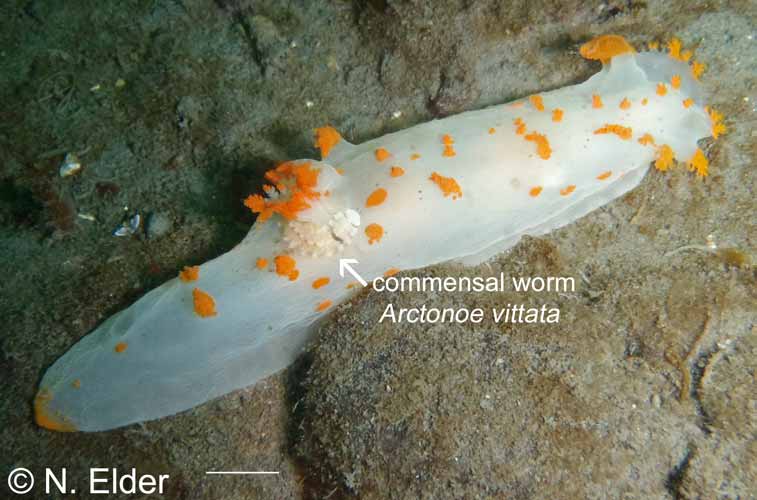
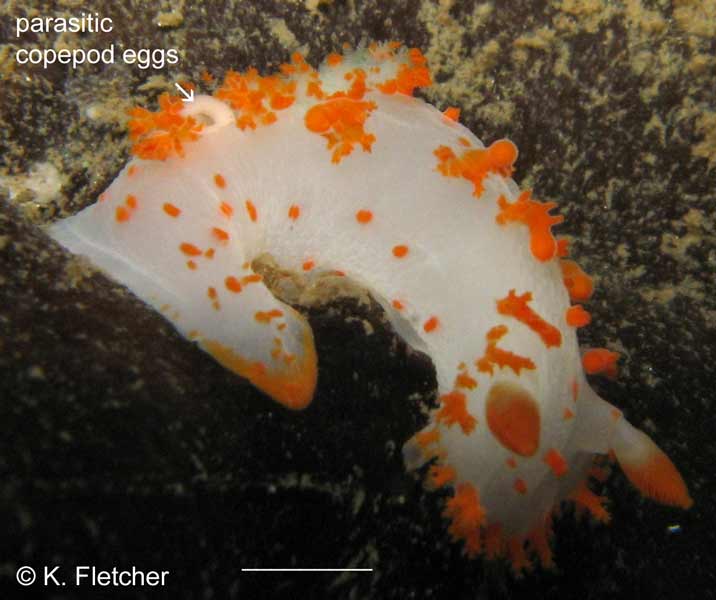 Freshwater Bay, WA, subtidal
Rich Passage, WA, subtidal
Freshwater Bay, WA, subtidal
Rich Passage, WA, subtidal
with commensal Red-banded Scaleworm with parasitic copepod eggs
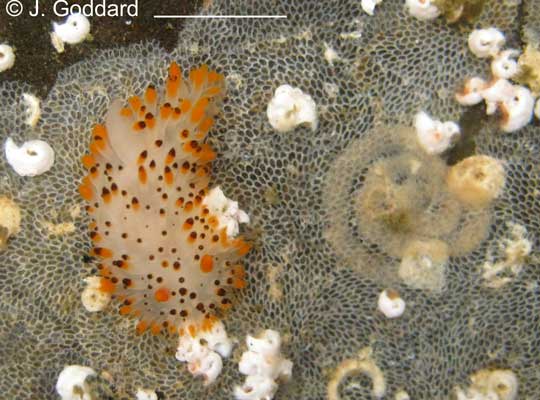 Whiskey Creek, OR, intertidalCrimora coneja Er. Marcus, 1961Rabbit Doridintertidal to at least 15m size to 23mm
Whiskey Creek, OR, intertidalCrimora coneja Er. Marcus, 1961Rabbit Doridintertidal to at least 15m size to 23mm
southern California to southern Oregon
This
is usually only seen at it's most northern range during very warm
summer. Photo shows its eggs and the encrusting bryozoan it feeds
upon.
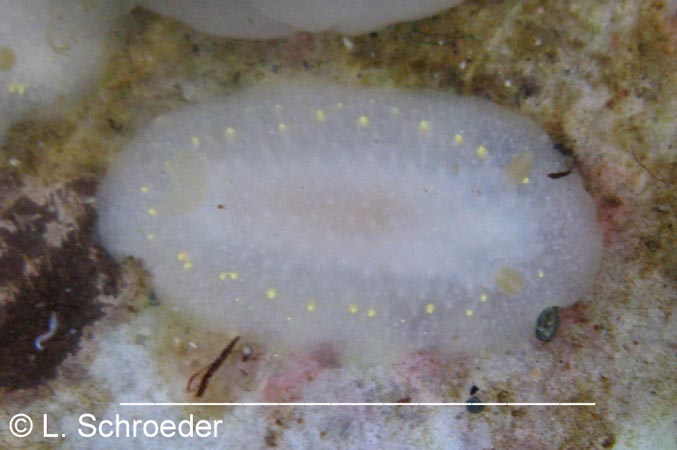 Port Hardy, BC, intertidal
Port Hardy, BC, intertidal
Cadlina modesta MacFarland, 1966Modest Cadlinaintertidal to 50m size to 45mmnorthern Mexico to southern AlaskaThis is infrequently found interitidally. It ispale in color with a series of yellow dots ringingthe dorsum. The rhinophores are usually yellow.
Cadlinidae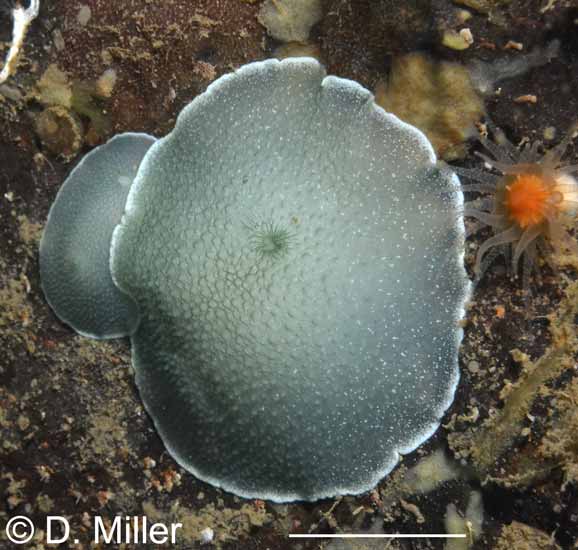
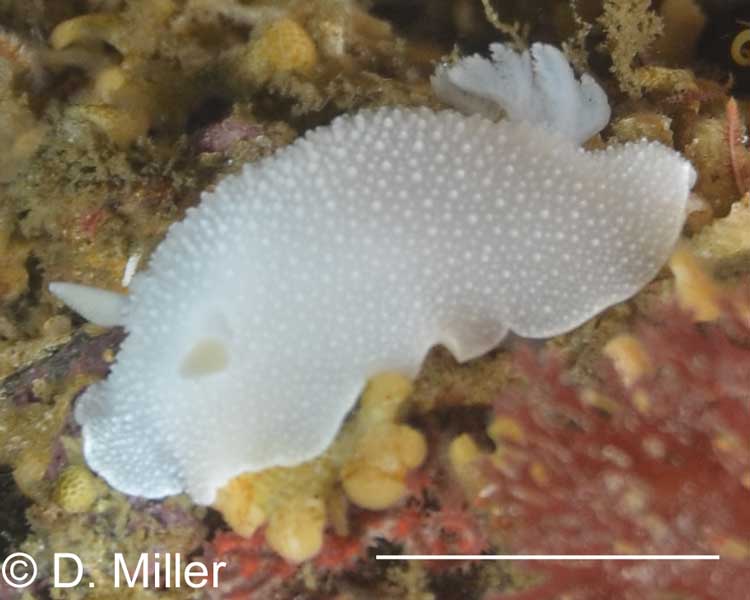
Howe Sound, BC, subtidal
Neah Bay, WA, subtidal
Aldisa albomarginata Millen, 1985White-lined Aldisasubtidal, 9-20m north WA to south BC size to 27mm
This
species has a greenish-white base color. Its dorsum exhibits
scattered white spots and a white lined margin. The full range
and depth of this species is not yet determined.
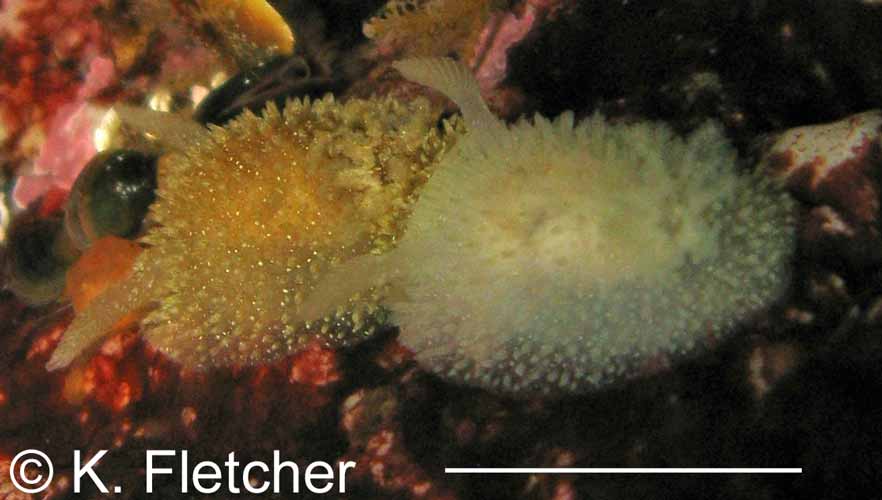 Sechelt Inlet, BC, subtidal
Sechelt Inlet, BC, subtidal
Acanthodoris atrogriseata
O'Donoghue, 1927
intertidal to 270m size to 27mm
This species is infrequently found intertidally. It may be white, golden, brown or
almost black. The papillae are tipped in yellow. The rhinophores
have white tips. This species was separated from A. pilosa, which is an Atlantic species. It is distinguished by longer rhinophores and pointed papillae rather than bumpy tubercles. Recent studies have also clarified differences between this species and A. brunnea. This species is more commonly found in the Pacific Northwest than A. brunnea.
Acanthodoris brunnea MacFarland, 1905
Brown Horned Dorid
intertidal to subtidal size to 20mm
southern California to southern BC
This
species is infrequently found intertidally. The body is brown with
blotches. It may have spots of black and white. The pointed papillae
are whitish on the top half. It is similar to A. atrogriseata. It smells strongly of cedar
when handled.
Low Point, WA, subtidal
Anacortes, WA, in aquarium
Cadlina luteomarginata MacFarland, 1966Yellow-edged Cadlinaintertidal to 45m northern Mexico to southern Alaska size to 45mmThis
is infrequently found intertidally. It is white with a distinct
yellow line rimming the dorsum. The stubby tubercles are tipped
with yellow. Similar in appearance to Acanthodoris hudsoni.
A recent genetic study has shown that there are at least 4
different species that look nearly identical. Further study is
proceeding. It is yet unclear if they can be identified by
external characteristics alone.
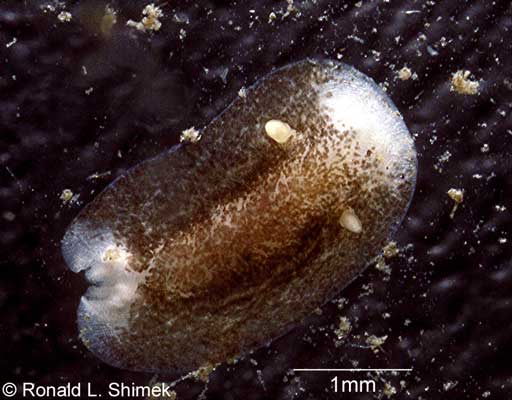 Barkley Sound, BC, subtidalLoy thompsoni (Millen & Nybakken, 1991)
Barkley Sound, BC, subtidalLoy thompsoni (Millen & Nybakken, 1991)
Thompson's Corambid
subtidal size to 6.5mm
southern California to central Alaska
This tiny species is hard to spot. It is flattened with a mottled brown and white dorsum. The ends are white.
Dendrodorididae
Cape Arago, OR, intertidal
Whiskey Creek, OR, intertidal
Doriopsilla fulva (MacFarland, 1905)White-spotted Dorid intertidal
to at least 20m southern California
to southern Oregon size to ~40mm
This
species is usually only found as far north as Oregon in very warm
summer years. It is part of a species complex and it can be
difficult to identify between them. It was previously considered
synonymous with D. albopunctata.
This species is usually pale yellow with white spots only at the
apex of the tubercles. There are no white spots between the
tubercles.
(previous name - Doriopsis fulva)
Point Hudson, WA, subtidal
Monterey, CA,
subtidal
Barkley Sound, BC, subtidal
T. catalinae and P. tricolor together
Triopha modesta Bergh, 1880
Modest Clown Dorid
intertidal to 80m size to 15cm
southern California to the Sea of Japan
This
species was recently separated from T. catalinae. It is more
common in the Pacific Northwest than T. catalinae,
especially in the
Salish Sea. The body may be translucent white to yellowish-white.
The rhinophores and gills are orange. The tubercles on the
back of the body are branched. It is sometimes found with a
commensal scaleworm near its gills, or a parasitic copepod.
Pleurobranchidae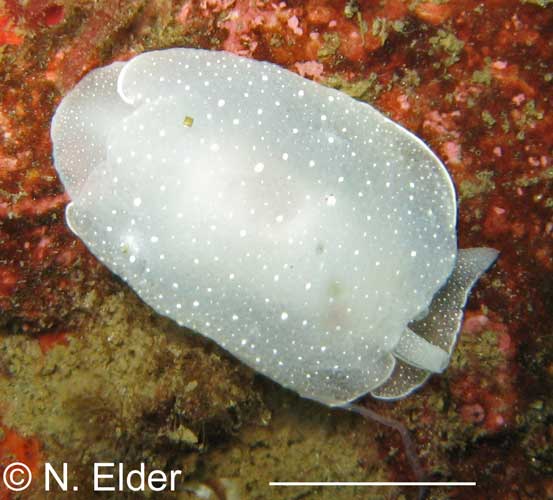
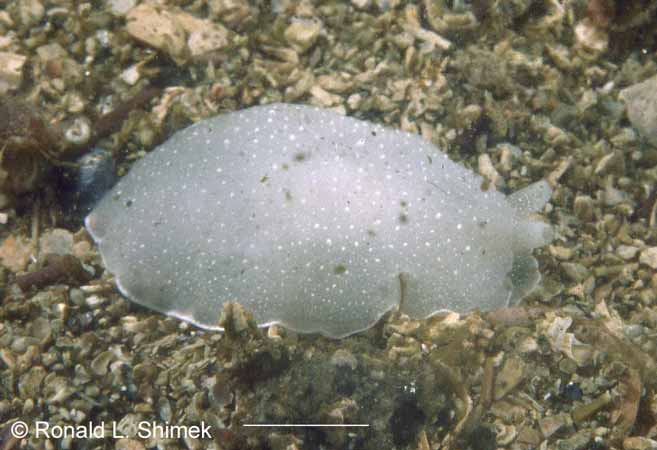
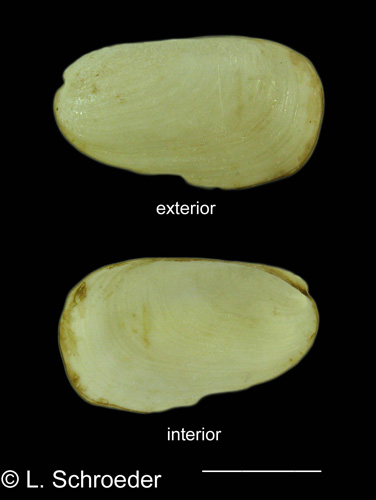
Freshwater Bay, WA, subtidal
Barkley Sound, BC, subtidal
Victoria, BC
Berthella chacei (J.Q. Burch, 1944)
Chace's Sidegill
intertidal to 33m southern California to Alaska to Sea of Japan size to 5cm
It
is rare to see this one intertidally in the northwest. It may be
translucent white to brown. There is a white line outlining the
dorsum and has a tuberculate surface. It has an internal shell. This species has been separated from Berthella california which is now a very southern species.
(previous name - Berthella californica)
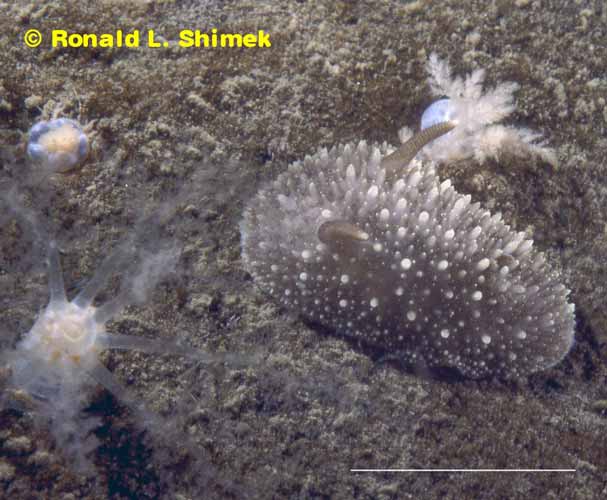
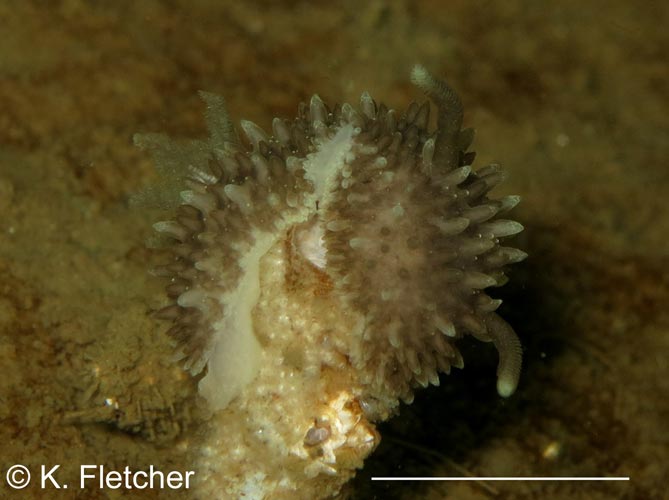 Waldron
Is., WA, subtidal Bremerton, WA, subtidal
Waldron
Is., WA, subtidal Bremerton, WA, subtidal
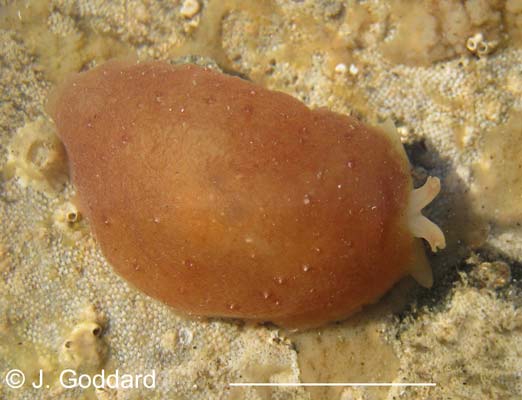
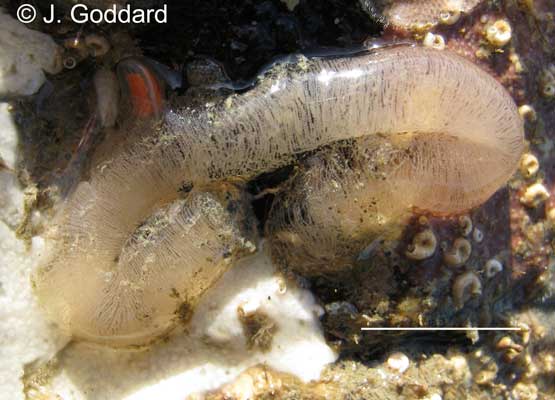 Estero Bluffs State Park, CA, intertidal, and egg massBerthella strongi (MacFarland, 1966)Strong's Sidegillintertidal
to at least 10m northern Mexico to
southern BC size to 25mmThis is
rarely seen, especially in the northern part of its range. It may
be pale to dark yellow and has a smooth surface. There is no
white line around the dorsum. It has an internal shell.
Estero Bluffs State Park, CA, intertidal, and egg massBerthella strongi (MacFarland, 1966)Strong's Sidegillintertidal
to at least 10m northern Mexico to
southern BC size to 25mmThis is
rarely seen, especially in the northern part of its range. It may
be pale to dark yellow and has a smooth surface. There is no
white line around the dorsum. It has an internal shell.
(previous name - Pleurobranchus strongi)
This page last revised: 7-2-2024
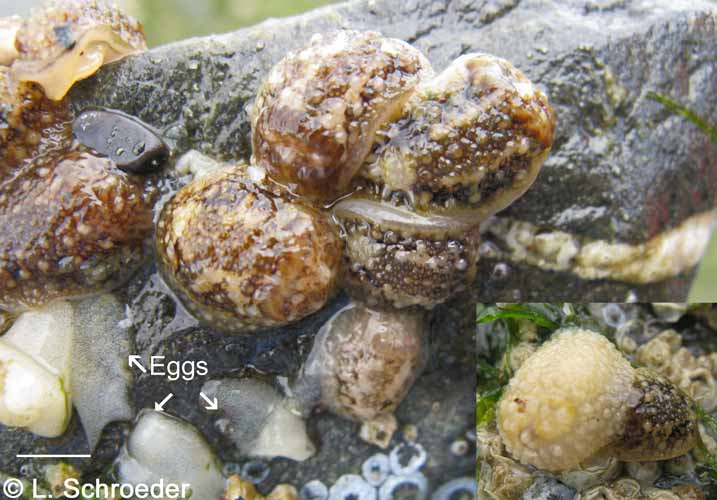 Oak Bay, WA, intertidal
Oak Bay, WA, intertidal
Onchidoris bilamellata (Linnaeus, 1767)Barnacle-Eating Nudibranch *intertidal to 30m size to 20mmnorthern Mexico to northern Alaska; circumboreal -
south to France, Connecticut and JapanThis is a common intertidal species and can be seen in large numbers in the spawning season. The white egg masses are often easier to spot than the nudibranch,
which blends into its surroundings. The body color is pale cream, but
often is heavily mottled with brown markings.
(previous name - Doris bilamellata) 



















